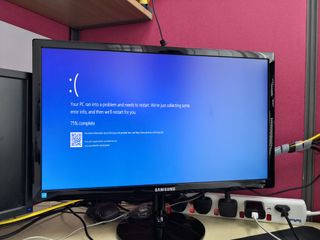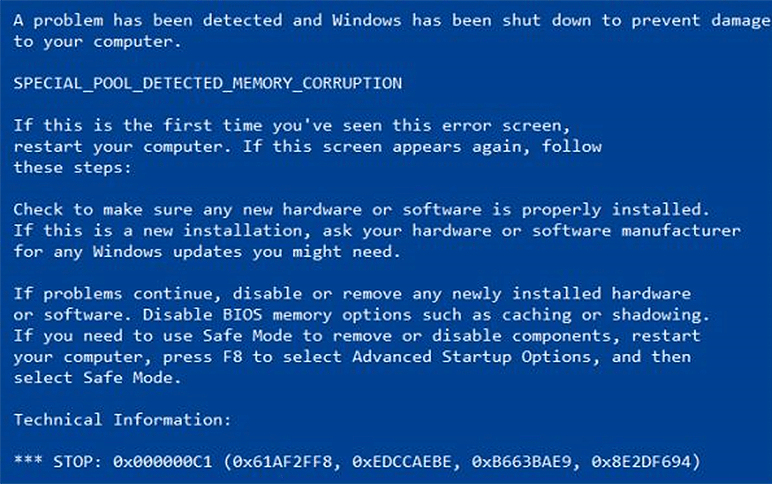How To Fix Bsod Windows 10 Command Prompt
How to Fix a Windows Blueish Screen of Death (BSOD)

Few things are more frustrating. You lot're in the middle of working on a projection, reaching a major milestone in a game or perchance only booting up your Windows ten computer and, just like that, the entire Os crashes and presents you lot with a Blue Screen of Death, ordinarily for no immediately apparent reason.
In Windows-speak, the term "Blue Screen of Expiry" is usually abbreviated as BSOD. It describes an error of some kind that hits the operating system difficult enough that it's forced to quit. Microsoft itself labels such errors with "stopcodes." Thus these errors may also exist generically named "stop errors." Here's an case that shows what a BSOD sometimes looks similar:

Understanding the BSOD Screen
The screen starts with an sometime-fashioned unhappy face emoticon " :( " (a colon, followed past an open parenthesis). Next, you meet a brief explanation that "Your PC ran into a problem and needs to restart." Windows writes one or more log files when a cease error occurs, so you see language nearly "collecting some fault info" and a counter that keeps track while it'due south writing that data (shows as "25% complete) above.
Microsoft provides a scannable QR lawmaking in modern BSODs (lower left) that yous can browse with a smartphone and look up that fashion. The message also provides a lookup URL for stopcodes, where you can enter a numeric stopcode (and where yous'll run across most mutual stopcodes, including the 1 shown above). The most common cease codes include:
- CRITICAL_PROCESS_DIED
- SYSTEM_THREAD_EXCEPTION_NOT_HANDLED
- IRQL_NOT_LESS_OR_EQUAL
- VIDEO_TDR_TIMEOUT_DETECTED
- PAGE_FAULT_IN_NONPAGED_AREA
- SYSTEM_SERVICE_EXCEPTION
- DPC_WATCHDOG_VIOLATION
Yous tin can also download the Microsoft Error Lookup Tool (current version: Err_6.four.5.exe) to await up numeric error codes at a command prompt or in PowerShell, if yous adopt.
In Windows x, BSODs Aren't Always Bluish
Before Windows 8 came forth in Oct 2012, BSODs always appeared on dark blue screens. These were brimming-full of text and instructions (see below). With Windows viii, Microsoft switched to a kinder, gentler format shown in the preceding screencap. They also whittled down the information that appears on screen. In fact, the background color in Windows 10 is sometimes light-green, which is why you may meet some of them called GSODs ("Greenish Screens of Death"). Here'due south an example of an onetime-fashioned, pre-Windows-8 BSOD to put this information into historical context:

Making Sense of BSOD Information
Though nobody wants to see a BSOD on a Windows PC, they do occur from time to time. In the vast bulk of cases, the PC volition restart itself automatically afterwards an error log, called a crash dump or a dump file (extension .dmp) is created. By default, Windows x stores dump files in one of two locations.
You can manage crash dumps through Avant-garde Arrangement Settings in Windows 10 (type "Advanced Organisation Settings" into the search box, and so click "Settings" in the Startup and Recovery pane). You can also choose to toggle "Automatic restart" to off hither, if y'all would prefer that any future BSODs stay on the screen until you get a adventure to see them and write downwardly (or take motion picture of) any relevant data.

If you select "Small-scale retention dump" as the choice for saving crash dumps, such files show upwardly as Minidump.dmp files. For all other selections, the crash dump is named Retentivity.dmp. Crash dumps become written to the %SystemRoot% folder, which ordinarily expands to C:\Windows. Past design, small retentivity dump files are express to 256KB in size. Other memory dumps will vary in size up to the size of memory on the PC where the dump is collected. Thus, on a PC with 16 GB of RAM, a Complete memory dump file will always be 16 GB in size (and other dump files, except for the pocket-sized retentivity dumps, can be as large as 16 GB, but volition often exist smaller).
Examining a crash dump file can exist helpful when troubleshooting related causes. For more details, run into our story on how to use a minidump file to prepare your Windows BSOD. That said, many users simply search on the stopcode and/or the numeric error code when seeking remediation advice. (Annotation that Microsoft calls that numeric code a "bug bank check code" or "problems check cord."
What To Practise When Troubleshooting a BSOD
The immediate trend post-obit a BSOD is to get right into fix-it mode, outset looking things up, and attempting repairs. Not so fast! Microsoft explains the entire troubleshooting procedure in its "Troubleshoot bluish screen errors (opens in new tab)" tutorial. While you can – and probably should – read the Microsoft advice in its entirety, hither'south a summary of fundamental recommendations:
- Shut down the Windows PC that experienced the BSOD
- Disconnect all USB-attached devices except for mouse and keyboard (or wireless dongles).
- Reboot your organization into safe mode from the Windows Recovery Environment (WinRE)
- If you recently installed new software, uninstall that software.
- If yous recently installed a new device driver (or your BSOD info points to a driver or device), uninstall or roll back that driver (if yous don't actually need the device you can disable information technology temporarily instead)
- Restart the PC, and come across if the BSOD recurs. If not, you lot've probably isolated the cause and can start researching some kind of fix.
If the BSOD recurs despite the items taken out of the pic past removing, disabling or uninstalling them, whatever's still left in the picture show remains problematic. At this indicate you desire to reboot into safe mode once more, and open up an administrative command prompt or PowerShell session. From the control line, enter these commands, one at a time:
- DISM /Online /Cleanup-prototype /Restorehealth
- SFC /scannow
The start of these two commands finds and replaces any damaged operating system components in the side-by-side filestore (aka WinSxS). The 2nd of these commands runs the System File Checker (SFC) and will repair any damaged files it finds.
Note that if SFC finds and fixes anything, you should run the command until it comes back with a clean nib of health (in some cases, I've had to run it 2 or iii times before it came dorsum clean). Notation further that running either or both of these commands can take some time to complete, specially if one or both find items in need of fixing. Here's what you lot want to see later on your final SFC run:

There's a consummate BSOD handling infrastructure available from Microsoft, built around a tool called the Windows Debugger (aka WinDBG). You tin download it as function of Microsoft'due south free Windows Developer Kit (opens in new tab) if you actually want to dig into the gory details. There are a lot of details to learn about, and minutiae to address, if you lot want to put this tool to work on crash dumps. For non-It professionals or not-developers, I recommend Nir Sofer'due south fantabulous BlueScreenView utility instead. It's gear up to automatically load the symbol tables information technology needs to resolve error codes, and it knows where to notice crash dumps in demand of assay. It as well presents crash dump information in a highly-readable form.
As an analogy, I forced i of my examination laptops (a Lenovo ThinkPad X390 Yoga) to blue screen at an administrative command line. There, I entered the cord taskkill /im svchost.exe /f. Warning: typing this cord into an administrative command prompt or PowerShell session will crash the PC immediately. That's because it kills a key program named svchost.exe (Service Host) that supports DLLs in the Windows runtime environment. Because most (if not all) Windows programs apply one or more DLLs this basically makes Windows inoperable. Thus, it causes an immediate BSOD with the CRITICAL_PROCESS_DIED stopcode (shown in the lead-in graphic for this very story).
When I fired upwards BlueScreenView on that PC, it institute the Retentiveness.dmp file that this BSOD created during its mail-crash cleanup stage. Here's what the application looks like:

The top pane of the window shows all the crash dumps it finds on the target PC. Considering there'due south only i in this instance, I shrunk it down to show as many details from the bottom pane as possible. Withal, the data in the top pane is of import, with data in certain columns of special interest. Column i shows the name of the dump file. Column iii shows the stopcode, which information technology labels "Bug Check String." Column 3 shows the associated hexadecimal fault code, 0x000000ef, which it labels "Bug Bank check Code."
For most genuine BSODs (remember, I forced this one to happen) the stopcode and the fault code volition often help afflicted users zippo in on causes and potential cures for their woes. In my experience, at least xc% of BSODs become fixable merely based on this information. That's because information technology will often be solved by disconnecting, disabling, or uninstalling related devices, drivers, applications, or updates – just as Microsoft recommends, and I summarized in the previous section.
What About that Other Problematic 10% of BSODs?
Some BSODs won't exist amenable to quick and easy fixes. When they come up, every bit they sometimes will, it'southward time to ask for help in getting things figured out. I tin can recommend two terrific sources of troubleshooting assist available online, each with its ain dedicated user forum specifically focused on solving BSOD problems. Likewise, each one stipulates sure requirements on users seeking BSOD assistance.
Source number one comes from TenForums.com (key disclosures: I am a VIP member of this community; I contribute input and suggestions to its members daily). The TenForums venue is in its BSOD Crashes and Debugging forum. Posting instructions are explicitly provided, along with a collection of BSOD tutorials, including those on WinDBG Basics,and how to Install and Configure WinDBG for BSOD Assay, Run BSOD Fault Troubleshooter in Windows 10, and Enable or Disable BSOD Automatic Restart in Windows 10.
Source number 2 comes from British PC security and troubleshooting site BleepingComputer.com. They operate a user forum named Windows Crashes and Bluish Screen of Death (BSOD) Help and Support. There, yous'll find pinned threads for the post-obit topics (all of which are worth reading through):
- Sysnative Blue Screen of Death (BSOD) University: A series of detailed questions readers should answer to ask the experts at Sysnative for help with BSOD problems.
- BSOD Posting instructions: what information users should assemble (based on downloading and running a Sysnative app) to obtain necessary dump files and content.
- BSODs only no Dump Files: instructions on how to configure a Windows PC to produce dump files whenever a BSOD occurs. Essential to know because diagnosis without dumps is nearly incommunicable.
Thus, y'all'll have to read up a bit, download some tools, run some scripts and/or collect some logs that yous'll submit to make a semi-formal request for BSOD aid. This will have i or more hours and force yous to exercise some homework earlier such assistance becomes bachelor. It may too involve numerous dorsum-and-forth communications, where you're asked to run additional diagnostic tools and collect boosted logs and data to shed more than light on your situation. Trust me: these guys know what they're doing. I've seen merely a scattering of issues where users did everything asked of them where the BSOD experts couldn't help them get things fixed.
Ultimately, where in that location's enough volition to get a Windows BSOD stock-still, there's a way to make that happen. Keep at it, and you'll learn this for yourself.
Source: https://www.tomshardware.com/how-to/fix-windows-bsod
Posted by: ferrellgially.blogspot.com

0 Response to "How To Fix Bsod Windows 10 Command Prompt"
Post a Comment